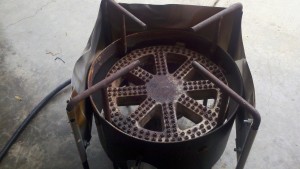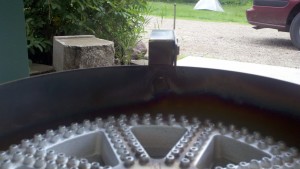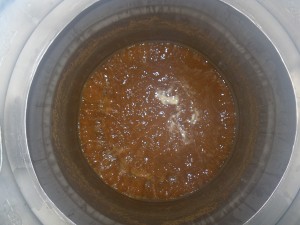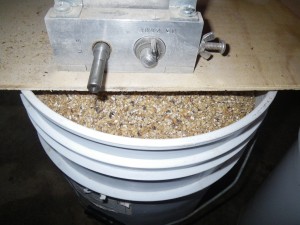Wisconsin weather in spring 2013 has been out-of-season, to say the least. A blizzard on May 2 & 3 capped off a long, drawn-out spring thaw. The weather didn’t really warm up until June. But now that it’s warming up, the humidity is making up for what the heat didn’t do earlier in the year.
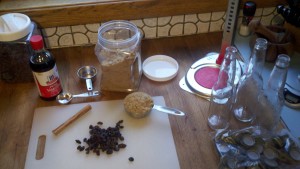 One of my wife’s favorite drinks is my homemade cream soda. It’s so good I decided to call it “The Myth”. OK, I’m actually naming it that because I don’t make it regularly. When I started brewing beer, I told Brandy I would make her a batch of cream soda every time I made a batch of beer. Well . . . let’s just say I owe her several batches of cream soda.
One of my wife’s favorite drinks is my homemade cream soda. It’s so good I decided to call it “The Myth”. OK, I’m actually naming it that because I don’t make it regularly. When I started brewing beer, I told Brandy I would make her a batch of cream soda every time I made a batch of beer. Well . . . let’s just say I owe her several batches of cream soda.
Lots of great things about this cream soda recipe:
- You can knock a batch out in about an hour and a half. Less, if you’re more organized than I am.
- There’s little to no alcohol in this beverage, so you can share it with your kids. (It is naturally carbonated, so there is a small amount of alcohol).
- No hops means it’s a great use for those clear bottles you’ve got laying around.
- Natural carbonation adds its own flavor to the beverage.
The Myth
Ingredients
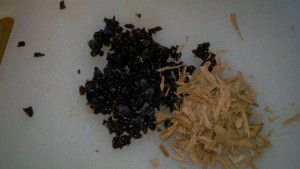 rounded 1/4 cup raisins, chopped
rounded 1/4 cup raisins, chopped- 1 stick Penzey’s Ceylon Softstick Cinnamon, crumbled
- 1 and 3/4 cup brown sugar, gently packed
- 1 tablespoon vanilla extract
- 1/4 teaspoon ale yeast (proofed in warm water)
- 4 quarts water
Method
- Put brown sugar and two quarts of water in a pan and start heating the water.
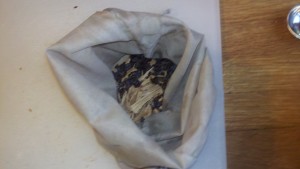 Chop raisins and crumble cinnnamon stick. Place in a food-safe mesh bag made to be boiled. I use a hop sack.
Chop raisins and crumble cinnnamon stick. Place in a food-safe mesh bag made to be boiled. I use a hop sack.- Place sack containing raisins and cinnamon in the pan and bring to a boil.
- Boil for 10 minutes. If you have time, a longer boil will bring out more of the cinnamon flavor. Experiment and find what you like.
- Place the yeast in a small cup with warm water to begin proofing.
- Sanitize twelve 12-ounce bottles and a one-gallon container.
- Add one quart of cold tap water to the one-gallon jug.
- Add vanilla extract to the jug.
- Cover the pan after removing it from the heat and place in a cold water bath to speed cooling. If you are in a rush, you can add ice cubes to the liquid.
- Once cooled, squeeze the bag to extract the liquid from the raisins and add to the jug. Top up the jug to one gallon with cold tap water.
- Fill the prepared bottles (I usually end up with about 10.5 – 11 bottles) and cap with crown caps.
- Place in a warm location for 3-5 days depending on temperature. Warmer locations mean less time to carbonate.
Notes
I recommend the Penzey’s softstick cinnamon because the flavor is so much better than the standard “cinnamon” you get in the grocery store. The flavor is smooth, yet intense. The sticks are soft and easy to crumble, so you don’t need any special equipment to break the sticks down.
I do not worry as much about contamination when I make homemade soda. We usually drink it within two weeks, so there isn’t really time for bacteria to take hold. As a result, I did several things I would never do when making beer: using ice to cool and dilute the liquid, allowing the sanitized bottles to stand on the counter uncovered and using straight-from-the-tap water to dilute the mixture.
WARNING!!!
There is a serious risk of exploding bottles. If you do not chill the bottles once you reach your desired carbonation level, the yeast will continue to digest the sugars and build pressure within the bottles until they explode.


